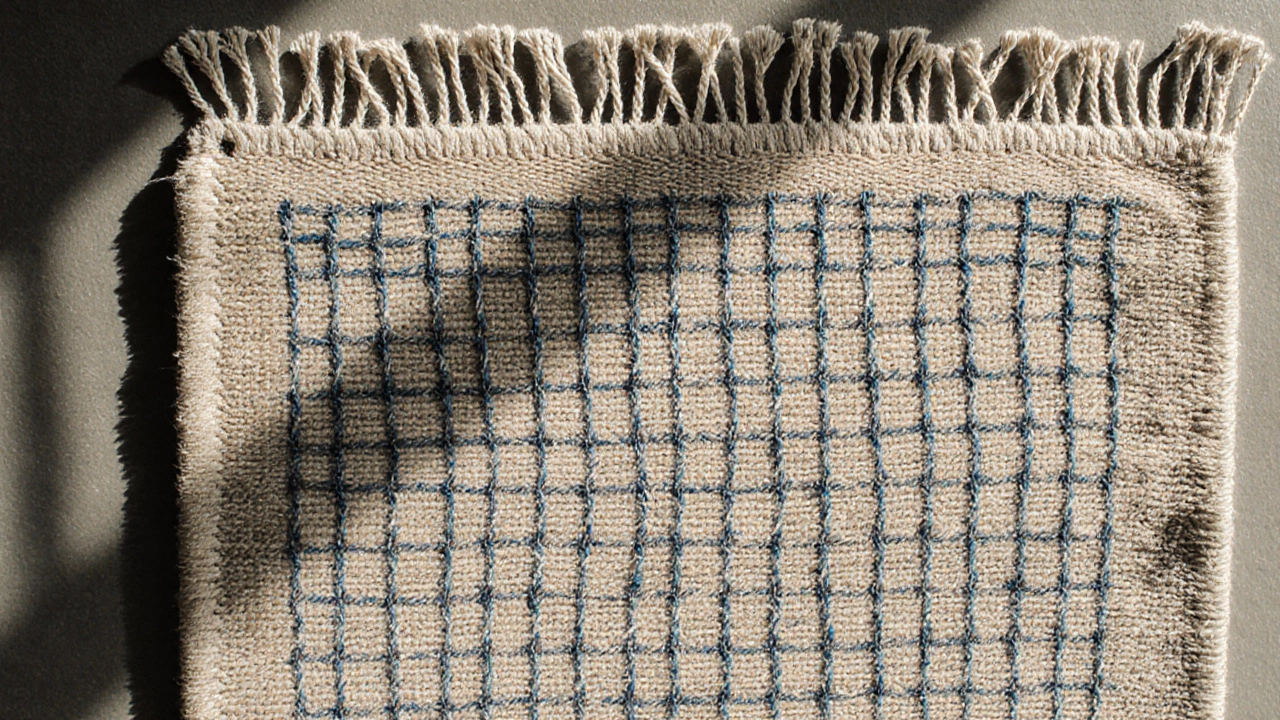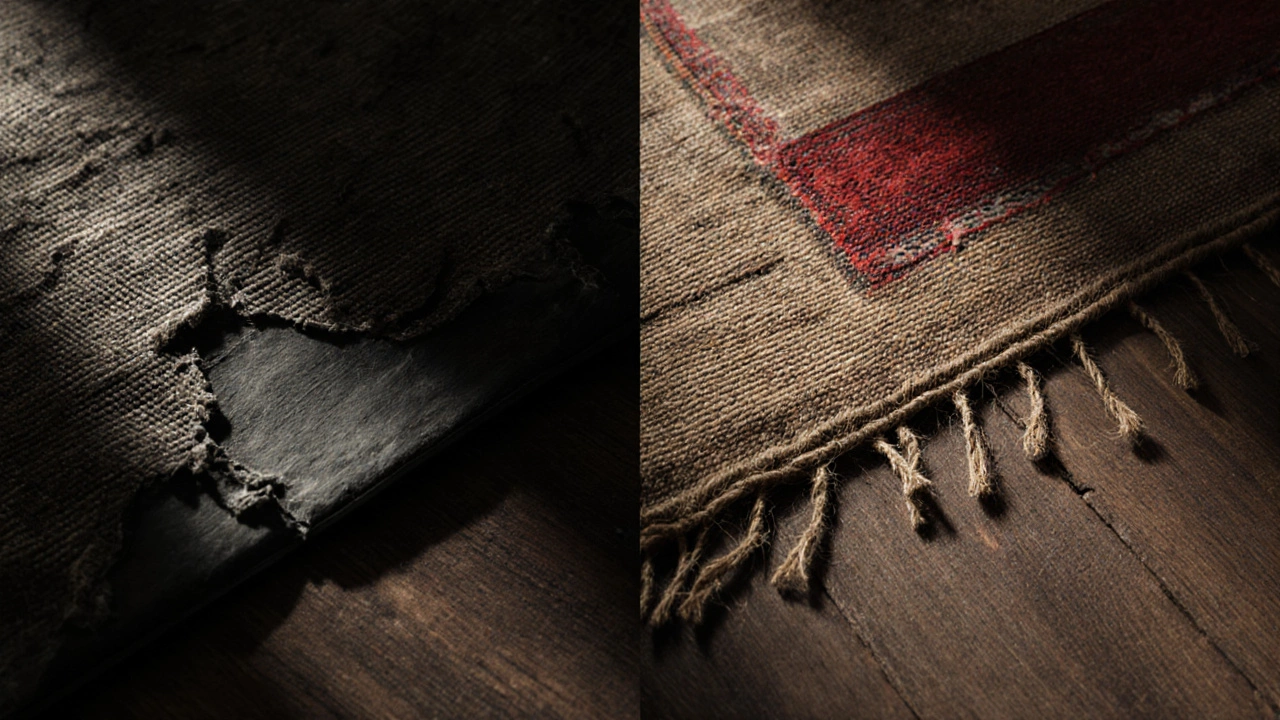How to Tell if a Rug Is Good Quality: 7 Key Signs You Can’t Ignore
 Nov, 8 2025
Nov, 8 2025
Rug Quality Assessment Tool
Rug Quality Assessment
Use this tool to evaluate rug quality based on the 7 key indicators from the article. Answer each question truthfully for an accurate assessment.
Rug Quality Assessment Results
Not all rugs are created equal. You can walk into a store and see two rugs that look almost identical-one costs $200, the other $800. What’s the difference? It’s not just the brand. It’s the quality. And if you’re spending hundreds on a rug, you need to know how to spot the real deal before you buy.
Feel the pile
The first thing you should do is touch the rug. Not just brush your hand over it-press down with your fingers. A high-quality rug has a dense, tight pile. If the fibers feel loose or you can easily see the backing through the top layer, it’s probably machine-made with cheap synthetic fibers. Good rugs, especially hand-knotted ones, have fibers packed so tightly that your fingers barely sink in. Wool is the gold standard here. It’s naturally resilient, holds dye well, and lasts decades. You’ll feel the difference: wool feels springy and cool to the touch, while polyester or acrylic feels flat and plasticky.Check the knot count
Turn the rug over. Look at the back. If you see tiny, even knots forming a grid, you’re looking at a hand-knotted rug. The number of knots per square inch tells you how detailed and durable the design is. A low-end rug might have 60-80 knots per square inch. A good one starts at 100. Fine Persian or Tibetan rugs can have 300-500 knots per square inch. More knots mean more time spent weaving, which means higher cost-and better longevity. If the back looks messy, with uneven knots or glue holding the fibers in place, it’s not hand-knotted. It’s tufted or glued, and it won’t last.Look at the fringe
The fringe isn’t just decorative-it’s part of the rug’s structure. On a genuine hand-knotted rug, the fringe is an extension of the warp threads that run the length of the rug. These threads are tied off by hand. If the fringe is sewn on or glued, it’s a red flag. A sewn-on fringe means the rug was machine-made, and the ends were later attached for looks. A good rug’s fringe will match the color and texture of the rest of the rug. It might be slightly uneven, but that’s normal-handmade means human hands, not machines.Examine the backing
The backing holds everything together. On a quality rug, the backing is made of natural materials like cotton or jute. It’s breathable, flexible, and doesn’t crack over time. Cheap rugs often have a rubber or latex backing. That might sound like it adds grip, but it’s a trap. Latex breaks down in heat and humidity, turns sticky, and can stain your floors. It also traps moisture, leading to mold. If you peel back a corner and see a thick, rubbery layer, walk away. Natural fiber backings are thin, woven, and flexible. You should be able to bend the rug without resistance.
Smell the rug
This one sounds odd, but it works. Bring the rug close to your nose. A new, high-quality wool rug might have a faint, earthy scent-like wet wool after rain. That’s normal. But if it smells strongly chemical, like plastic, glue, or ammonia, it’s a sign of synthetic dyes, low-grade backing, or heavy chemical treatments. Some manufacturers use formaldehyde-based finishes to make rugs look new or resist stains. These are toxic and can off-gas for months. A good rug shouldn’t make you cough or get a headache. If it does, it’s not worth the risk.Test the color
Dye quality matters more than you think. Take a damp white cloth and rub it firmly on an inconspicuous corner of the rug. If the cloth picks up color, the dye wasn’t fixed properly. High-quality rugs use natural dyes from plants, insects, or minerals-these fade slowly and beautifully over time. Synthetic dyes fade unevenly and can bleed when wet. Also, look at the pattern. On a good rug, the design looks the same on both sides. If the front is vivid and the back is faded or blurry, it’s likely printed, not woven. Handwoven rugs are symmetrical. Printed rugs are flat and one-dimensional.Compare the price
You can’t fake craftsmanship. A hand-knotted wool rug from Iran or Nepal takes months to make. A weaver might spend 8-10 hours a day for six months on a single 8x10 rug. That labor costs money. If you see a 9x12 hand-knotted wool rug for under $500, it’s either a scam or a mislabel. The average price for a good quality 8x10 hand-knotted wool rug starts at $1,200. That’s not cheap-but it’s an investment. A well-made rug lasts 20-50 years. A cheap one lasts 2-5. Multiply the cost by lifespan, and the expensive one is actually cheaper per year. Think of it like buying a pair of shoes: $100 boots that last 10 years beat $30 sneakers that fall apart in a season.
What to avoid
Avoid rugs labeled "Oriental style" unless you know they’re authentic. "Style" usually means machine-made copies. Watch out for rugs with plastic-like shine-they’re often made from polypropylene. Skip rugs that come with a warranty that says "resists stains"-real wool doesn’t need chemical coatings. And never buy a rug without seeing the back. Most sellers won’t show it, but you should insist. If they refuse, they’re hiding something.Real-world example
Last year, a client bought a rug from a big-box store for $350. It looked perfect-rich colors, intricate pattern. Six months later, the pile flattened in high-traffic areas, the backing cracked, and the fringe started unraveling. She brought it back. The store said it was "normal wear." But a $350 rug made with synthetic fibers and glued backing isn’t meant to last. She replaced it with a hand-knotted wool rug from a trusted artisan for $1,800. Five years later, it still looks new. The difference? Materials, knots, and care.Quick checklist
- Press the pile-should feel dense and springy
- Check the back-look for even knots, not glue or rubber
- Inspect the fringe-is it woven in or sewn on?
- Smell it-no chemical odors
- Test the color-damp cloth shouldn’t pick up dye
- Compare both sides-the design should match
- Price check-hand-knotted wool rugs start around $1,200 for 8x10
If you pass all these tests, you’ve found a rug that will outlast trends, pets, and kids. It’s not about looking fancy-it’s about lasting.
Are wool rugs worth the extra cost?
Yes, if you want a rug that lasts. Wool is naturally stain-resistant, fire-retardant, and resilient. It doesn’t flatten easily and holds color better than synthetic fibers. A wool rug can last 30-50 years with basic care. Synthetic rugs start to look worn after 3-5 years. Over time, wool saves you money.
Can a machine-made rug ever be good quality?
Some machine-made rugs can be durable, especially those made with high-twist nylon or wool blends. But they’ll never match the longevity or detail of a hand-knotted rug. Machine-made rugs are faster to produce, so they’re cheaper. If you need something for a high-traffic area on a budget, a well-made machine-made rug can work-but don’t expect it to become a family heirloom.
How do I clean a high-quality rug?
Vacuum weekly using a suction-only setting-no beater bar. Rotate the rug every 6 months to even out wear. For spills, blot with a clean, dry cloth and mild soap. Never use steam cleaners or harsh chemicals. For deep cleaning, hire a professional who specializes in hand-knotted rugs. Most rug cleaners don’t know how to handle wool or natural dyes properly.
Does the origin of the rug matter?
It does, if you care about authenticity. Rugs from Iran, Turkey, Pakistan, Nepal, and India have centuries of weaving tradition. They use techniques passed down through generations. That doesn’t mean rugs from other places are bad-but rugs labeled "Persian" that are made in China are often misleading. Look for the country of origin on the label, and research the seller’s reputation.
What’s the difference between hand-tufted and hand-knotted rugs?
Hand-knotted rugs are made by tying individual knots onto warp threads. They’re durable and reversible. Hand-tufted rugs use a gun to push yarn through a backing, then glue holds the fibers in place. They’re faster to make and cheaper, but the glue can break down. Tufted rugs aren’t reversible, and the backing is often rubber or latex. They’re not as long-lasting.